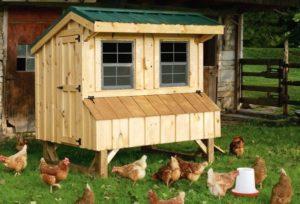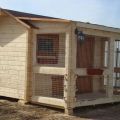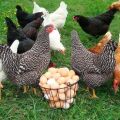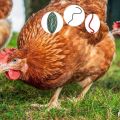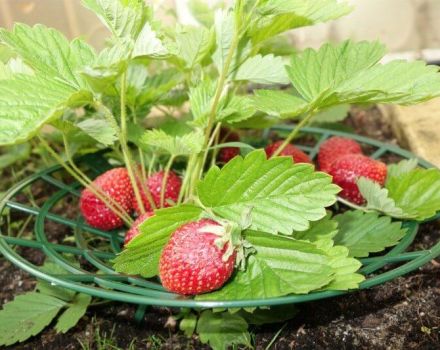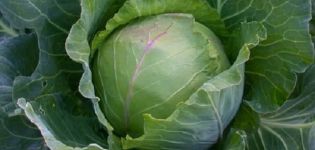Do-it-yourself rules for arranging a chicken coop inside and outside, mistakes
When arranging a chicken coop, many features should be taken into account. To keep the birds comfortable and healthy, it is necessary to maintain the correct temperature regime, make perches, install nests and drinkers. Full ventilation and the desired lighting mode are of no small importance. Before carrying out work, you should definitely familiarize yourself with the common mistakes of novice poultry farmers.
Space layout
Chickens can be placed in any room. However, it must be properly equipped. First of all, it is worth determining the number of chickens. There should be no more than 2-3 birds per square meter.
When equipping a poultry house, it is worth considering the season in which it is planned to keep chickens. For the summer, an ordinary uninsulated barn is enough. To keep chickens throughout the year, the hen house is insulated.
When planning a chicken coop, it is worth choosing a free area for walking the birds. This area is fenced off with a metal mesh, which is pulled over the posts. The area of the site should be 1.5 times the size of the shed.
The aviary should be 2 meters high in height. It is recommended to cover it with a net on top. This will help prevent contact with predators. Part of the territory should be covered with a roof. This place will become a reliable protection from precipitation and sun.
When arranging a place for walking, it is worth digging about 30 centimeters of the net into the ground. The birds like to dig undermines. As a result, they can get out from under the fence.

Basic requirements for a chicken coop
When creating a room for laying hens, there are many key features to consider. It is important to select the materials for the floor and walls in advance.
Poultry walls
The most practical solution would be a frame. It is recommended to sheathe it with boards or slabs on each side. It is worth placing an insulating layer between them. Sawdust and straw can play its role. Sheathing with boards is carried out from the inside. You can also use plywood or other similar materials.
It is recommended to paint the chicken coop with ordinary water-based paint. The scent should go and the paint should dry. An excellent solution would be to use lime for the walls.
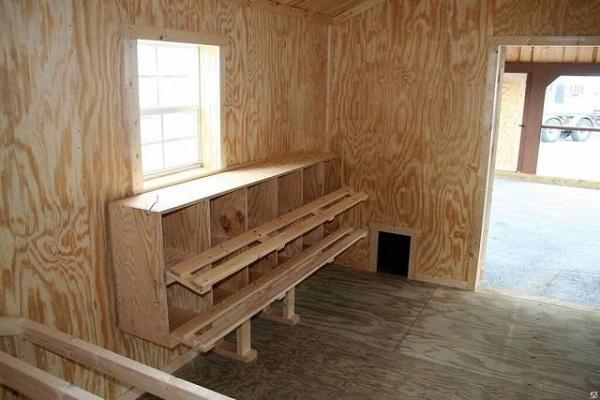
Floor and bedding of the chicken coop
The floor is made of wood or concrete. An adobe floor is a good option. It is best to use wood. To do this, lay insulation on the rough layer, and then use edged boards.
It is important to ensure that the floor surface is smooth and level.This will help to avoid damaging the chicken legs.
The floor should be whitewashed with lime or use special wood preservatives.
It is recommended to cover the floor boards with sawdust or straw. The thickness of this layer should be 10-15 centimeters. This bedding makes bird care easier. When dirty, there is no need to clean or mop the floors. In such a situation, it is recommended to remove the litter and add a new layer.
In winter, the thickness of this layer is increased to 20 centimeters. Otherwise, the chickens may freeze. This is very dangerous during oviposition.

Chicken coop microclimate
In order for the chickens to feel good and not get sick, it is worth providing a suitable microclimate in the room.
Temperature
First of all, it is worth choosing the right temperature regime:
- In summer, the temperature should not exceed 20 degrees. In hot weather, the appetite of birds decreases, which leads to a decrease in clutch.
- In winter, the temperature should be at least 10 degrees. When the indicator decreases to 5 degrees, a natural decrease in egg-laying is observed.
In order to maintain normal temperature parameters, it is recommended to provide heating and ventilation of the room. In winter, it is worth using autonomous heaters, infrared lamps. You can also use incandescent bulbs. It is important to install heaters as safely as possible so that they do not start a fire.
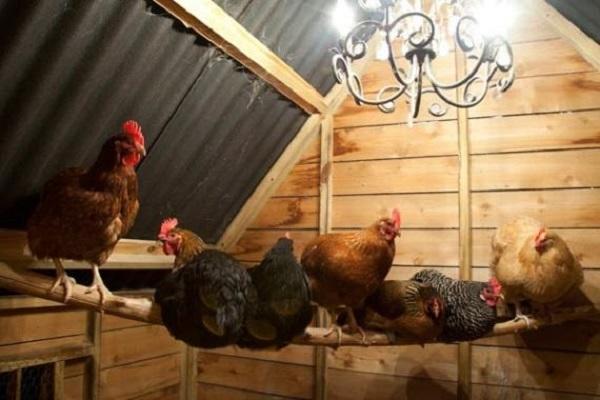
If a not too cold winter is expected, it is enough to fill in the cracks in the coop and make a deep bed of dry peat or straw. Chickens should also ensure the correct stocking density. This will ensure that the required room temperature is maintained during the first frost. When the old layer is compacted, it is not recommended to remove it. In such a situation, fresh material is added.
Coop ventilation
Regardless of the season, it is recommended to maintain adequate ventilation. It is best to ventilate the room by opening doors and windows. This method suffices in the summer.
In winter, this method will take heat away from the birds. Therefore, it is recommended to carry out passive ventilation using ventilation pipes. The supply should be located below the exhaust. This will ensure proper ventilation.

Poultry lighting
To maintain egg production, daylight hours should be 13-15 hours. For this, infrared lamps or incandescent lamps are used. There is enough natural light only in summer. A decrease in daylight hours indicates the arrival of winter, which is fraught with the cessation of egg laying.
The internal structure of the chicken coop
It is not difficult to equip the room with your own hands. To do this, it is recommended to think over the location of perches, install nests, make feeders and drinkers for birds.
Location of perches
First of all, it is recommended to make comfortable perches. Chickens spend the maximum time on them. To do this, it is worth making poles from a bar. Their cross-section can be 4x7 or 5x6 centimeters.
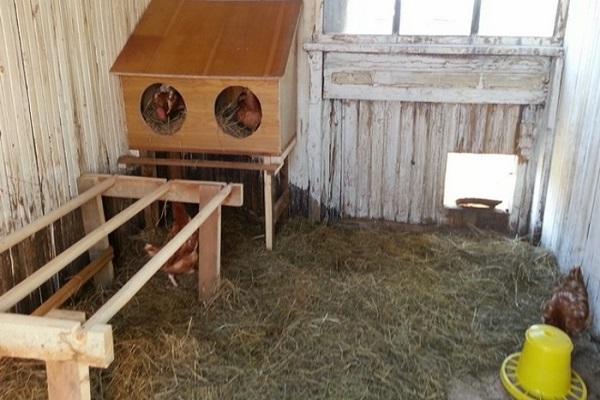
The perches should be comfortable for birds. The birds will not be able to grasp very thick or thin poles, which will provoke loss of stability. Thin poles often bend under the weight of chickens.
The bar should be processed with a plane. This will help make it round. After that, sanding is carried out with sandpaper. It is important that the perch has a smooth structure and does not contain any sharp protrusions or burrs.
The location of the perches is also important. They are fixed horizontally or vertically, in the form of a ladder. The first option is more comfortable for chickens, but it takes up a lot of space. The second type is more suitable for small spaces. It helps save space. However, birds may experience discomfort on such a perch.
When equipping perches, it is worthwhile to correctly determine their length. It is recommended to set aside 30 centimeters of a pole for each bird.The length of the perch is selected taking into account the number of chickens. They should be fixed at a height of 50 centimeters. If the perch is horizontal, it should be removed 25 centimeters from the wall. The rest are recorded at intervals of 35 centimeters.

Installation of chicken nests
When installing nests, it is worth choosing a secluded area in the hen house. It is important that there is no draft. To increase the productivity of poultry, it is recommended that the structure provide sufficient stability.
Make nests free. The depth is 40 centimeters, the height and width of the structure is at least 30 centimeters. It is recommended to place a bedding inside. To do this, use straw or sawdust. It is also allowed to use hay.
As a rule, the nests are made of wood. The frame is made of planks or timber; sheathing in the form of plywood is used on top. It is also permissible to use a box of a suitable size or any other container. You should definitely make a low ladder in the form of a ladder. It is placed at each nest.
When choosing the quantity, it should be borne in mind that one nest is enough for 4 layers. But qualified poultry farmers recommend using 10 egg-laying places for 20 chickens.

Feeders and drinkers
In summer, birds dig the ground all the time in search of food. Therefore, it is recommended for them to pour the food onto the floor. Chickens will be able to find it even under the bedding.
It is better not to use this method in winter. This is due to the impressive thickness of the litter. In addition, the feed will rot over time. It is recommended to use feeders during this time. They can be purchased or made by hand. Store structures, which have a mesh division on top, would be a good solution.
When arranging a room, it is worthwhile to provide drinkers. Beginners often choose old pots or similar utensils for this. However, in this case, the water will have to be constantly changed. The downside of such devices is the risk of getting inside the droppings. As a result, the water quickly becomes dirty. It is strictly forbidden to consume such liquid.
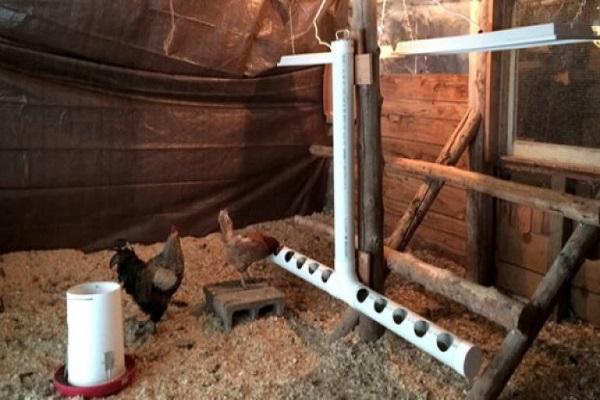
It is better to place special drinkers indoors. You can buy them at the store. Also, good drinkers are made from plastic bottles. Thanks to this design, the chicken's head reaches the water, but the risk of droppings entering the inside is excluded.
Swimming places
Chickens love to clean their feathers with dust. In winter, such baths should be done right in the chicken coop. To do this, it is recommended to take a small trough and fill it halfway with wood ash. It helps to not only clean the feathers but also eliminate fleas..
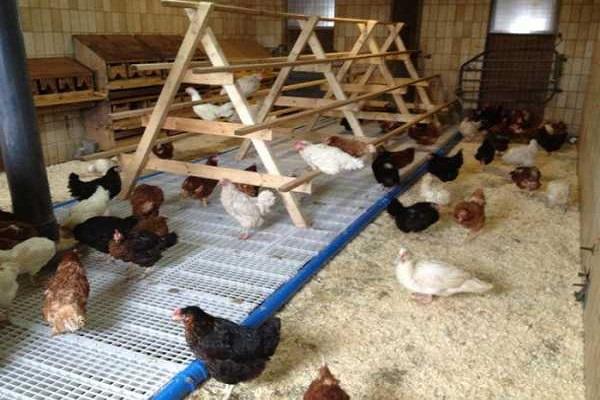
Possible mistakes
Inexperienced poultry farmers can make various mistakes:
- Leave an earthen floor in the chicken coop. It should definitely be concreted and covered with a layer of sawdust.
- The perches are improperly equipped. You cannot make a hierarchical ladder out of poles. This will lead to fights.
- Drinking water is poured into basins. This leads to intestinal infections. As a result, egg production falls, and even there is a risk of death of the bird.
The correct arrangement of the chicken coop is a complex process. To achieve good results, it is recommended to take into account many features - the structure of the perch, the size of the nest, the appearance of the feeders and drinkers. It is also worth maintaining an optimal temperature and providing good ventilation.

